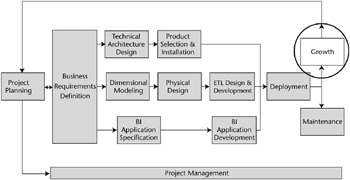Chapter 16: Managing Growth
| | ||
| | ||
| | ||
Theres no rest for the weary
Overview
At this point, unless you plan to include real-time capabilities, you have reached the last step in the Lifecycle. By now, you should have completed the deployment of your first business process dimensional model to great success. The tendency at this point is to feel like youve finished the whole project. We encourage you to celebrate your achievement, and we hate to rain on your parade, but the arrow that goes from the Growth box back to the Project Planning box in Figure 16.1 reminds you that the Lifecycle is an iterative process. You have two major tasks at this point. The first is the obvious extension of the warehouse by adding the next priority business process row in the bus matrix, and by adding new user groups. The second task, now that youve had some success, is to dig in and get the DW/BI system fully woven into the fabric of the organization. This acceptance and integration of the DW/BI system by the business does not happen by accident , and it relies more on political and organizational skills than technical skills.

Figure 16.1: The Growth step in the Lifecycle
We start this chapter with a look at how the Lifecycle works as an iterative process and what it means to go back through the Lifecycle for the next implementation round. In particular, we revisit the major sections of the Lifecycle from the perspective of the second and subsequent iterations. Then, we focus on techniques for integrating the DW/BI system into the organization. Most of this effort involves activities that fall under the marketing and communications categories. We offer several strategies for accomplishing business acceptance and integration of the DW/BI system.
In addition to business acceptance, you should seek technical acceptance as well. This typically shows itself in the form of downstream information-based systems, like the Customer Relationship Management (CRM) system, turning to the DW/BI system to take advantage of its value-added contents. This downstream usage is an important part of growing the system, but you will need to manage this usage in terms of performance and service level requirements.
| | ||
| | ||
| | ||
EAN: N/A
Pages: 125
- Challenging the Unpredictable: Changeable Order Management Systems
- Distributed Data Warehouse for Geo-spatial Services
- Intrinsic and Contextual Data Quality: The Effect of Media and Personal Involvement
- A Hybrid Clustering Technique to Improve Patient Data Quality
- Development of Interactive Web Sites to Enhance Police/Community Relations